Hoppers, a new restaurant, has opened in Soho, London, bringing South Indian and Sri Lankan flavors to the area. Step inside, though, and a visit feels less like a passage to India and more like a time-travel trip to the 1980s—and not the hipper iterations the fashion world continues to selectively mine.
From the wooden wall paneling, to the brown tile-topped tables, to the orange-hued lighting, to the Marcel Breuer Cesca chairs (popularized and widely copied in the 1980s), hanging plants, and mustard-colored walls—it’s a celebration of all the bad-taste stylings from 1980s restaurant interiors that we’d previously consigned to the dustbin.
Designed by Article, a fledgling London design studio, it’s inspired—the studio said—by the Tamil region of India, taking direct influences from traditional toddy shops in this area of the country. But the 1980s spin on the execution is undeniable.
Hoppers follows the revival in the US of the long-derided “fern bar”—a homey style popularized in the 1970s, and long since abandoned with the growth of the craft cocktail movement.
Traditional trappings of the fern bar, which exploded in the 1970s and ’80s, were stained glass Tiffany lamps, hanging ferns, and pale or pine wooden tables—think TGI Friday’s and you’ll get the picture. They began life as an initiative to encourage women to visit bars, which at the time meant a focus on sweet, novel-sounding cocktails. Henry Africa’s, opened in 1970 in San Francisco, was the originator of the style.



